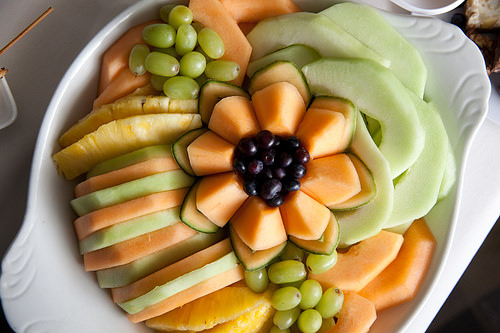
If you have just started a catering business, wondering how to charge for catering services can leave you asking many questions.
However, it really doesn’t have to be that complicated, you just have to know your numbers. In my experience, catering can be much more profitable than running a restaurant because you know exactly how much food you need so there is little to no waste.
You will also know exactly how much money you are going to make for each event. Assuming there are no mistakes 🙂
Price out Your Catering Menu
The first thing you will need to do is price out your menu by doing a full cost analysis. This will take some time but once you set it up, it will be an invaluable tool that you will use over and over again.
You can create this master document using Microsoft Excel (another great Office product!). The reason I recommend doing this in Excel is so you can link formulas that will automatically update if your prices change on the inventory items. This way you will setup the document once and then all you have to do is plug in your current prices to see what your menu items cost you.
For each inventory item you will need to break it down so you have a per unit cost. This should be the lowest unit of measure you use for this item.
For example, if you use a granulated chicken base and the lowest unit of measure is a tablespoon, then you need to calculate how much a tablespoon of that chicken base costs you.
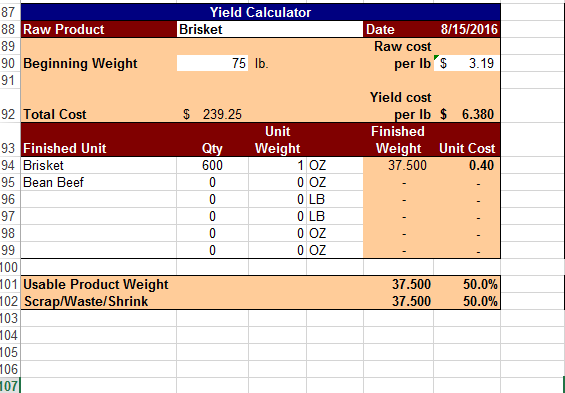
So how do you do that? Well it depends on the item but I do recommend setting up a template like this so you can then copy and paste the template and just update the values for each inventory item.
On many items, the labeling will give you all of the information you need.
Let’s say the chicken base costs $7 for the container and there are 300 tablespoons in it, simply divide the cost by the number of servings ($7/300 servings = $.02 per serving)
For items with information on the label it is easier. For items that are sold by the piece it is easy as well.
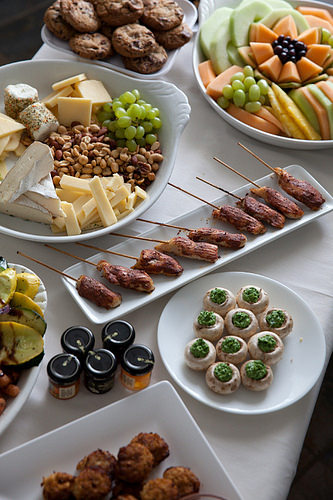
Say you by chickens by the case that are sold by weight. However, most of the time they come with a set number of pieces. Just divide the entire cost of the case (price per pound X total weight of the case) by how many pieces are in the case.
There will be other items that you will need to calculate the yield of the product. What I mean is there are some products that you will not be able to use 100%.
Say you buy a 50 pound bag of onions, well by the time you peel and process the entire bag do you think it is going to weigh 50 pounds?
Unfortunately your supplier doesn’t care and is still charging you for 50 pounds!
After you have calculated the yield on these products, you can come up with a unit cost. Let’s say this bag of onions was $20 and you yielded 47 pounds of usable onion. The cost per ounce would be $.027 ($20/47 pounds/16 ounces per pound)
Click here for even more tips on how to increase sales
One thing you may want to consider is adding a cushion for mistakes, waste or employee theft.
Assuming you have staff working for you they are not always as careful as you the owner would be so decreasing your yield by 5-10% will give you a more accurate yield.
Again, this will take some time but it is well worth the investment. Once you have done this for every item you can then use formulas to build you menu items.
It is important that you use formulas that are attached to your master inventory list so they will automatically update when you enter new prices.
Go through each menu item and add up all inventory items associated with it. This will give you your total costs.
From here there are many ways to come up with a sales price. I recommend looking at a few and choosing one with what you feel comfortable with.
The simplest and fast way would be to multiply your costs by 3 which will give you a 33% food cost. This is the industry standard. If your total costs for a plate is $3.17 then you would sell at $9.51. This is an ugly number though, you could probably round that up to $9.59 or even $9.99.
If you want to shoot for a set food costs percentage, then simply divide the total cost by that percentage. For the same plate as above you would need to sell for $12.68 ($3.17/.25). Again, I would round that up to $12.99.

You can create a master page like this so you can quickly see your margins or food costs as a percentage of the sales price. This is ultimately what you are after.
By linking all of the items to their respective inventory items, you can update your entire menu by simply entering in your current prices for the products you buy. Doesn’t’ that sound great?!
Before you come up with a set price call some of your competitors and get their menus in your hands. Try to find similar menu items and see what they are selling for. If your competition is selling that plate for $13.99 well then that is where you want to be!
You may need to ask about portion sizes to be sure you are comparing apples to apples. Don’t worry about this, just call from a cell phone and they will gladly answer your questions if you sound interested in ordering some food!
This is also a good way to see how they operate!
Price out A Custom Catering Menu
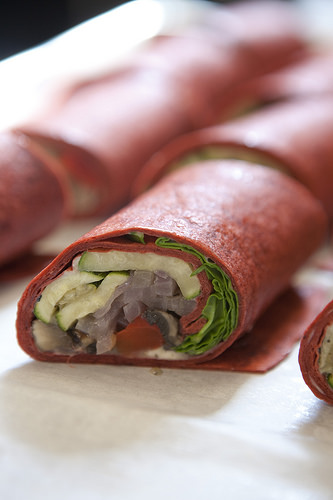
Obviously pricing out your set menu makes it easy going forward to calculate your prices. Once a quarter or so, simply update your prices in your inventory guide to see if you need to adjust your prices.
However, as I’m sure you know by now if you are taking orders, there are a lot of custom menu request in the catering world!
For these, your master inventory guide will still be helpful as I’m sure most of the items you need will be on it. You may just need to know the current price of a certain protein that you don’t normally keep in stock.
Simply call your vendor and ask! Or if you can order online you should be able to look and see what they have and even how many they have in stock.
If you haven’t ever calculated a yield on it before your vendor may be able to give you some insight. However, usually I just do a quick Google search and you should be able to get pretty close.
From here, simply follow the same steps from the previous section to come up with your per plate costs. If you need any help with this just let me know in the comments or send me an email.
Charge for Labor for Catering Services
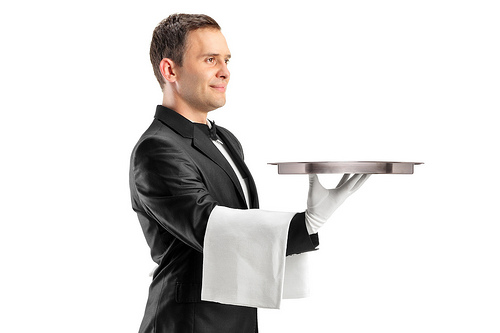
Another aspect of charging for catering services is whether or not to include a service charge. If the order is just a drop off or delivery then you may just want to charge a nominal delivery fee.
You may want to consider offering FREE delivery as a competitive advantage.
However, for full service catering I would recommend including a service charge. There are several ways to calculate this.
The simplest and the one we use the most is a percentage based fee. On the weddings we perform this can range from 20-40% or more depending on what all they require us to do.
This ensures that your labor is at least paid for (or maybe you make a little money on it) so that the profit on the food is untouched.
This is where you can really make some good money.
Let’s say you have a wedding coming up and the food is selling for $3,000. Based on the level of involvement you decide to include a 30% service charge or $900.
Well it might take 5 staff members 10 hours each to complete this wedding on the day of. Plus you might have 1-2 staff doing prep for 4-8 hours the day before.
Assuming the high end you have a total of 66 labor hours and if you pay your staff an average of $10/hr. well then you have $660 in labor into this event. Actually more like $710 when you include payroll taxes. So you are covered with your service charge and you have a few bucks to spare!
You could also reverse engineer this fee and simply charge the customer your exact labor costs. Once you get some experience under your belt you will be able to accurately estimate how many labor hours you will have into an event. So you could calculate your actual labor costs plus add a buffer.
Use This Software to Create Quotes in Minutes!
Maybe you calculated the 66 hours but rounded up to 70. Well then you would have only charged $700 but for the most part you still would have been covered.
Just like with the menu you, might want to try several ways to calculate this costs at first and see which of the numbers you feel most comfortable with.
Charge for Rentals
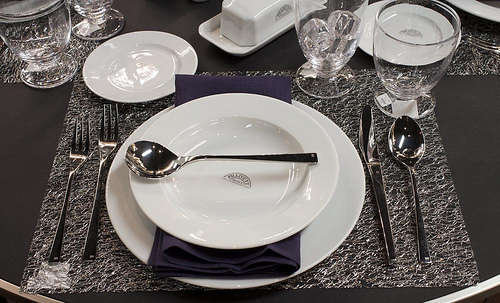
You may or may not be dealing with rentals on your event. If you start doing more weddings these will become more popular.
We like to handle the rentals for our clients as a convenience and a competitive advantage. Many other caterers won’t deal with this stuff.
Rentals include items like:
- Linens
- Utensils
- Plates
- Glasses
- Barware
- Tables
- Chairs
- Tents
- Lights
Most rental companies will give you (the caterer) a discount if you do enough business with them. Make sure you ask about it regardless of how much business you do.
How much or how little you deal with the rentals will determine how you charge for them. Either way you can’t really charge a lot or it will become more attractive for the customer to just do it themselves.
For example, the rental company will most likely charge a delivery fee. So you could price your fee just under that so they see a little savings and you get some extra sales.
We have gotten to the point where we are basically sales reps for the rental company. When we do our consultations with the brides we have pictures of the most common inventory items so our customer doesn’t even have to deal with the rental company.
We like this because we can add a few pennies here and there to each item so we make a little money off the rentals.
To Buy or Not To Buy
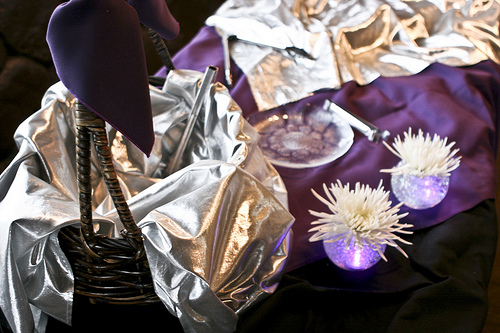
If you do enough business with the rental company you might find yourself asking, why do I have pay these guys so much money!
After a big wedding month Chris and I were looking at a P&L and saw we spent over $5,000 with the rental company in that month. That was us just being a middleman for our customers.
A light bulb went off and we immediately started researching linens. If you have space for storage and access to a household washer & dryer I would recommend buying linens for almost every event you need them.
For most basic linens (polyester) you can buy them for around $10/piece online and they rent for $16-18/piece. It’s a no brainer, you immediately make a couple dollars on the first sale. Then each time you can rent them out again it is straight profit (except for the washing and drying)!
For specialty fabrics or weird colors it is not as attractive to buy as they are more expensive and the change you might sell them again is not as high.
The next thing we started buying is silverware. We found most people are not that picky with silverware and it doesn’t take much space to store.
They cost around $.80-.90 apiece and rent for around $.45 apiece. So you have to sell these twice to break-even but you will find that most people want real silverware at their weddings and you won’t have a problem making money on them.
We had built up an inventory of about ~150 dinner knives and forks when we got lucky and landed a 300 person plated meal. They needed a salad fork and teaspoon in addition to the dinner knife and fork.
We couldn’t miss this opportunity to build up our inventory!
So we basically spent the entire service charge (happened to be a healthy one!) and now we had 300 of each of the 4 utensils. This was great because now there were only a few busy weekends a year where we had to rent utensils.
You should think of buying some of these rentals as an investment. If you spend a year using some of the service fees and profits from your bigger events buying some rental items you will find the profits rolling in later on down the road.
Conclusion
I hope you found these techniques on how to charge for catering services useful! As you price out your menu it will get easier and easier.
You don’t have to invest in software like Microsoft Office or catering software but it will make life much easier and save a bunch of time for you.

That was a complex scenario that you broke down well. I completely understand your breaking down of costs and using that as a basis for your quotes and profit margins. My sister used to run a restaurant and she never actually worked out how much her costs were before setting prices. They also did not buy their raw products from a supplier (instead they used a supermarket where costs are more expensive). In the end because they didnt work out their upfront costs and work out the amount that they should be charging accordingly they ended up making a huge loss. Completely stupid of her really and she never listened to any advice. Something like this article would probably have helped her.
I’m sorry to hear about your sister Evie, that is a tough situation. Not knowing your costs is like driving blind and buying all of your products at retail instead of wholesale pricing would make it almost impossible to make money. Hopefully she at least learned from her experience!
Wow! There are some awesome tips in this article. I didn’t realize how much detailed calculating it takes to come up with the cost per unit. And there are so many avenues you can go down with catering . I have never catered but I have made homemade pound cakes and sold them. This article is very informative.
Thanks Loretta, I would encourage you to even cost out your pound cakes (which sound delicious). It might let you know if you need to raise your price or hopefully it will show you are making a good profit!
You’ve done a really great guide here. I don’t have a catering business, but I have always thought about opening up a restaurant or maybe a food truck some day. Now I will have to think about maybe starting a catering business. I love how well you broke everything done and how clearly you explained all the steps for findings out costs and figuring out profit. The example you did was great and really helped explain things. Job well done!
Thanks Pete, I’m glad you were able to learn from the post. When you get your business started be sure to check out our eBook for even more tips on how to grow your sales!
A very detailed breakdown of the topic. Excel is an excellent tool for any starter business trying to cut costs and realise a return on their investments. When the business takes off, it would be prudent to invest in a relevant software package as your business grows. I’m also in the fast food/catering business, although on a part time basis and will use some of your tips as my business grows.
Yes George, I’m a big fan of Excel and other Office products. They are very helpful in the business world.
This post has been so helpful! I’m going to bookmark it to make sure I don’t lose it. All the details you provided really makes it easy to understand and all the tools you suggest as well.
I don’t have a catering company, but I do make cakes and cupcakes. This has really helped me understand how to put a price on what I create.
Who knows, maybe one day I’ll expand to catering 😉
Thank you so much!
You’re welcome Liz, I’m glad you learned how to charge for your cakes and cupcakes. Even if you don’t expand fully into catering you could certainly sell a bunch of wedding cakes!
Living in a seaside tourist town we see so many foreigners come here to set up a restaurant business only to fail with their endeavors. It’s a shame as most of the time the food is well made and the variety of cuisines make a nice change.
I have always wondered what makes people think that the catering business is easy, especially without having the necessary knowledge to make a sustainable business.
Good information here, if I decide to thrown on my whites I’ll be sure to come back and learn from your expertise.
Thanks for the comment Danny. You’re right, for some reason people think opening up restaurants or catering businesses are easy but fail to do the research they need to know how to operate successfully. Knowing how to charge for your food is key in making sure your profits are where they need to be.
Jeremy, this info is exactly what I’m looking for to help my niece begin her catering business. Thanks so much!!
You’re welcome!